Executive Summary
- SuitCase™ X-TREME™ 8VS wire feeder weighs 34 percent less, and is 43 percent smaller, than DCI’s previous wire feeder.
- SuitCase X-TREME 8VS wire feeder substantially lowered strain on DCI’s welders.
- Multi-operator, multi-process inverter racks save labor costs associated with switching leads.
Big Boats, Confined Spaces and Huge Savings
Dakota Creek shipyard reveals how inverter racks can save $180,000 annually, while lightweight wire feeders improve operator efficiency.
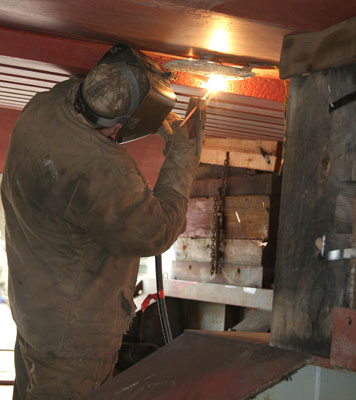 |
| Because multiprocess inverter rack systems enable operators two switch between carbon arc gouging (shown here), flux cored welding and Stick welding, they can save shipyards thousands of hours in productivity losses.
|
There are shipyards that build ships, and there are shipyards that build ships efficiently by staying on the cutting edge of technology. Dakota Creek Industries (DCI) in Anacortes, Washington, is one of the latter.
To reduce operator stress and to weld as efficiently as possible, DCI is in the process of converting its welding fleet to the newest technology. Two products from welding leader Miller Electric Mfg. Co. feature prominently in this conversion: the compact, lightweight SuitCase™ X-TREME™ 8VS wire feeder and multi-operator “inverter racks” with welders such as the XMT® 350 with Auto-Line™ power management technology.
The SuitCase X-TREME 8VS feeders weigh 34 percent less and are 43 percent smaller than DCI’s previous feeders. By lowering weight and increasing maneuverability, these feeders lower operator stress. Considering that DCI, a self-insured company, pays $3,200 for a typical strain injury, promoting operator wellness pays big dividends.
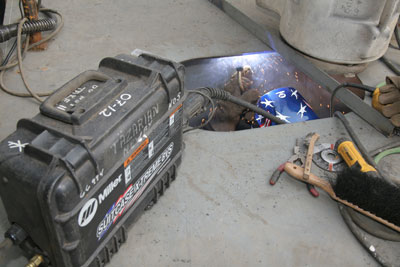 |
| Because of its compact size, the SuitCase X-TREME 8VS easily fits through portholes such as this one.
|
DCI’s 6-arc inverter racks pay even bigger dividends. Because a CC/CV inverter with an output of 425 amps can perform every welding process required (Stick, TIG, MIG, flux cored and carbon arc gouging with 5/16-in. diameter carbons), DCI operators do not need to swap machines or reroute leads when switching processes.
While DCI’s actual savings remain confidential, a similar shipyard with 50 welding operators–but using older welding technologywould potentially spend $180,000 per year (4,000 man-hours) changing leads. If this theoretical shipyard invested in eight new 6-arc inverter racks, which cost approximately $200,000, the efficiency of these inverter racks would provide a payback in just 18 months and provide a 66 percent ROI.
Defect Free
Founded in 1975, DCI today employs 290 people and fabricates and repairs tugs and barges, steel and aluminum yachts and high-speed aluminum ferries. Stationed on the deepwater Guemes Channel, DCI can build and repair larger vessels. The company has earned a reputation for quality workmanship, getting repeat local business and garnering new customers from across the country. For example, DCI’s newest effort involves fabricating the Grant Candies (292 ft. long x 59 ft. wide) and Ross Candies (309 ft. long x 65-1/2 ft. wide), both offshore oilfield vessels bound for Gulf of Mexico.
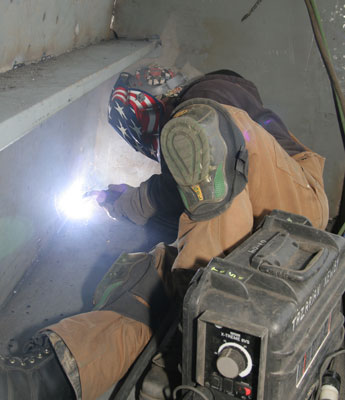 |
| Operators at Dakota Creek report that the SuitCase X-TREME 8VS provides soft arc starts without any wire stubbing, helping prevent rework.
|
All of DCI’s welds must meet standards set by such organizations as the American Bureau of Shipping (ABS), U.S. Coast Guard or Lloyd’s Register. All seams must be x-ray quality and all fillet welds must be free of defects. Each project has specific delivery dates that, if not met, lead to penalty fees. While each ship varies, most are built from A36 ABS Grade A steel with other components built out of grades AH, EH, stainless steel and aluminum. The Grant Candies and Ross Candies features steel ranging from 5/16- to 2-in. thick.
While DCI mostly uses the flux cored welding process (the Grant Candies consumed about 50,000 lbs. of E71T-1 flux-cored wire), the process for steel-hull vessels starts by using an E6010 Stick electrode for all open-root butt welds, seam welds and hole seams. While initially slower, the Stick process provides better quality and lower overall cycle time in this application.
“On open root welds, we found that running flux-cored wire drew in atmosphere from the back side of the weld,” says DCI welding supervisor Wes Hill. “Atmospheric contamination creates pin holes in the weld, which means that we would have to dig deeper when back gouging the weld. That takes more time and makes it more difficult to ensure weld quality.”
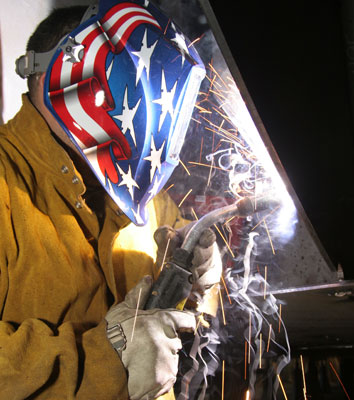 |
| Dakota Creek pairs the SuitCase feeder with Bernard’s 400-amp Q-gu because, “Bernard guns are nice because they’re small; they’re not big and bulky,” says Wes Hill, welding supervisor. He also notes the Q-gun’s neck configuration options improve joint access, which is important give the tight spaces involved with ship fabrication.
|
Hill refers to the fact that welding codes require back gouging all welds down to new metal and welding from both sides of the plate to ensure complete fusion.
The need to shift between the Stick, flux cored and air carbon arc gouging process prompted DCI to jettison its old welding units and adopt multiprocess (CC/CV) inverters and multi-operator inverter racks.
“The time savings of CC/CV inverters is huge. You can Stick, air-arc, wire feed and TIG with the same machine,” says Hill. “This saves the operators several hours a day by eliminating the need to look for and trade power sources with another operator and then rerouting welding leads.”
As DCI is still in the process of phasing out all of its older welding units, Hill knows from painful experience that it typically takes an operator about two hours to swap machines and reroute leads. Even if an operator only needs to do this twice per week, the large number of welders in typical shipyard adds up to several thousand man-hours of wasted time and hundreds of thousands of collars in lost profits (see below for a financial calculation). However, now that DCI has more than 20 six-arc inverter racks and numerous individual inverters strategically located throughout the yard, its operators rarely need to change machines.
Miller Economic Evaluation Summary – Shipyard Example
|
Estimated Annual Savings (present minus proposed costs*)
Welding Investment**
Annual Depreciation (Line 2 divided by 5 years)
(assumes straight line depreciation)
Annual Savings After Depreciation
Profit after Taxes (66% of Line 4)
Annual Cash Savings (Line 5 plus Line 3)
Return on Invetment (Line 6 divided by Line 2 X 100)
Payback Period (line 2 divided by Line 6 X 12 months)
|
$180,000
$200,000
$40,000
<
$140,000
$92,400
$132,400
66.2%
18.1 months
|
*Assume the shipyard uses a combination of CC-only welders, CV-only welders and/or multioperator welders not suitable for carbon arc gouging or flux cored welding. Because operators need Stick for open root welds, flux core for the fill passes and carbon arc gouging to back-gouge each weld, they need to switch machines and/or reroute leads twice per week. Each switch takes two hours, making for a weekly total of 200 hours. Assuming 20 weeks of hull fabrication per year, operators waste 4,000 hours each year. At an overhead rate of $45/hour, the yard pays its valuable welders a total of $180,000 for a task that can be eliminated.
** Approximate list price of eight XMT 350 inverter racks with six-arcs each.
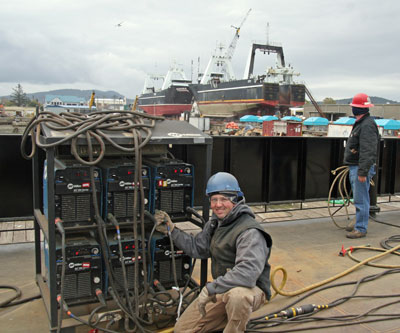 |
| Because of its tough shipyard environment (“If it’s going to get broken, we’re going to break it”), Dakota Creek consistently volunteers to test new Miller products. Here, weld lead Matt Purcell is shown with the multiprocess inverters used to field test Miller’s exclusive Auto-Line technology.
|
Steady Course
The XMT 350 features Miller’s exclusive Auto-Line power management technology. Auto-Line technology provides three key benefits that improve performance: the ability to maintain a rock-steady arc despite primary power fluctuations within a 190 to 630V range; a primary power draw of just 17.8 amps at rated output on 460 VAC primary (which is a 25 percent advantage over competitive 350-amp inverters); and the flexibility to accept any type of primary power (190 to 630V, single- or three-phase, 50 or 60 Hz) without any physical linking mechanisms.
Auto-Line technology uses a “boost converter.” This circuit boosts the primary input power—whether it’s 208, 220, 240, 460, 575 V or anything in between—to a higher voltage. After being regulated, this power then becomes the source voltage for the actual inverter section of the power source. This ensures that the inverter has sufficient power as long as the primary power remains within a +37/-59 percent of the nominal 460V power. For companies where dirty power created issues led to blown circuit boards or capacitors on inverters with physical linking systems–and DCI was one of these–the XMT 350 provides a solution.
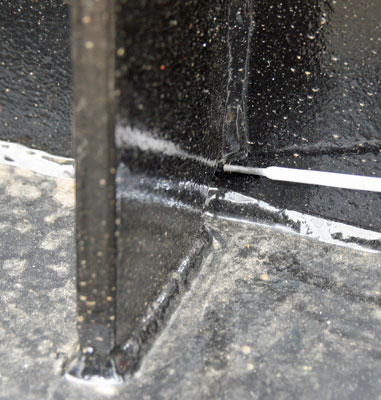 |
| Customers return to Dakota Creek because of the shipyards’ attention to quality. This includes “wrapping” the ends of welds around stiffeners (indicated in this photo with the end of a Stick electrode) to eliminate a potential source of cracking.
|
“You’re better off going to the newer inverters and getting rid of your older machines,” says Hill. “New inverters will also draw a lot fewer amps, and finding sufficient power can sometimes be a challenge.”
In addition to surviving dirty power conditions, Miller inverters also survive harsh shipyard conditions.
“The Pacific Northwest is famous for its rain, but Miller inverters have held up extremely well in this wet environment,” says Alan Robertson, a sales representative with Central Welding Supply. “Between the salt air, sand blasting and painting in the shipyard, plus moving equipment around all the time, Dakota Creek represents pretty harsh conditions.
Trial by Water
 |
| “Using smaller, lightweight feeders makes all the difference in the world when moving through the double bottom of a boat and all its tanks,” says Wes Hill, welding supervisor, Dakota Creek. Compared to larger feeders, the SuitCase X-TREME 8VS cuts weight by up to 33 lbs., or 43 percent.
|
Because DCI represents a real-world torture test, Robertson consistently brings them new welding technology to assess.
“If it’s going to get broken, we’re going to break it,” says Matt Purcell, weld lead, Dakota Creek Industries.
When Miller began introducing its new SuitCase X-TREME 8VS wire feeder, a product especially designed for shipyards, Robertson immediately thought of DCI.
Robertson has helped DCI transition from large, steel-covered suitcase-style feeders that were heavy and could barely fit through a porthole to heavy-duty plastic-cased feeders and eventually to the SuitCase X-TREME 8VS, which is small enough (12-3/4-in. tall by 7-1/4-in. wide) to fit through a 14-in. hole.
“The smaller the better,” says Hill regarding wire feeders. “The average ‘lightning hole’ we crawl through is a 24- x 18-in. oval. By going to the X-TREME 8VS wire feeders, we cut the weight down by 35 lbs. That cuts the weight in half and makes it much easier for the operator.”
The X-TREME 8VS holds an 8-in. spool of .030- to .062-in. flux cored wire. The smaller size means that operators must change out wire spools more often, but the lighter weight and improved accessibility offers a greater advantage.
“Even though we have to change out the wires more often, it’s better because it saves us time by making employees more productive,” says Purcell. “They are happier using this equipment, and it saves us time and cost due to injuries.”
The X-TREME 8VS is built to withstand the damp and dirty atmosphere inherent to metalworking in a shipyard. The polypropylene case withstands bumps and bruises while keeping out the dangerous combination of water and abrasive contaminants (dirt/metal/ dust) that can adversely affect wire feeder performance. The feeder features a circuit board dipped in epoxy to protect it from such elements.
DCI also reports that the X-TREME 8VS feeders offer excellent arc starts and performance that cuts down on the weld repair time associated with wire stubbing.
“The soft arc is nice,” says Hill. “The arc just starts out crisper and the weld puddle wets better. The wire doesn’t ‘noodle’ the way it did with our older feeders. ”
The major benefit of the X-TREME 8VS feeder, however, is reduced operator strain. This ranges from the basic effort saved by lifting and carrying a lighter machine to a reduction in injuries caused by heavier equipment. DCI claims that the lower weight reduces the number of work-related strains. Not only does this reduce medical bills, it prevents downtime associated with injuries and guarantees that more work is completed in a shorter period of time.
“The average cost for a strain injury is $3,200, and that’s on the low end,” says Hill. “Lighter-weight feeders help prevent strain injuries and improve overall operator efficiency. That’s a lot better alternative than having some miss work time or paying out any money for insurance and medical bills.”
|
Portable Feeder Comparison
|
Feeder Weight (empty)
|
Wire Weight/Size
|
Total Weight
|
Dimensions
|
|
SuitCase X-TREME 8VS
|
28 lbs.
|
15-lb. spool/
8-in. hub
|
43 lbs.
(34% lighter)
|
H: 12.75 in.
W: 7.25 in. (43% smaller)
D: 18 in.
|
|
Larger feeders
|
35 lbs.
|
30-lb spool/
12-in. hub
|
65 lbs.
|
H: 15.5 in.
W: 9.0 in.
D: 21 in.
|
King of the Sea
The combination of the XMT 350 and X-TREME 8VS wire feeder have helped DCI reduce the hassles associated with welding as their work gets larger and more complicated. Configuring the multi-process power sources in packs of eight and six that can be easily moved from module to module has helped reduce operating costs and downtime. Lighter-weight wire feeders have reduced work-related injuries and made it easier for welders to perform difficult welds in tight and unforgiving conditions. These changes have helped the company more efficiently produce a product they are respected for.
“When a boat leaves here, we like it to be the best boat possible,” says Hill. “That’s why we get return customers. People who have had ships built by others even come to us for repair because Dakota Creek has built its reputation on quality craftsmanship.”
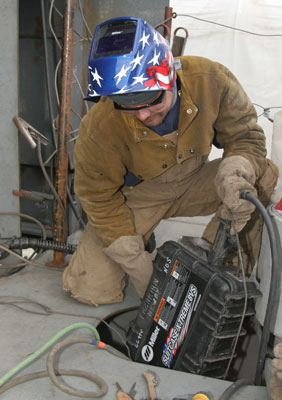 |
| The reality of shipyard welding means that sometimes operators use the wire feeder’s gun cable to drag them across the deck or lower them to the next level. Since shifting to the SuitCase X-TREME 8VS, the industry’s most durable small wire feeder, Dakota Creek has eliminated many sources of feeder damage.
|
Not a Perfect World
Unlike vocational school welding lab or indoor welding shop where much of the work can be brought to a welding bench, shipyards have no choice but to bring the welders to the work site. Operators must lower equipment dozens of feet down into tight spaces, through tiny portholes and then perform a skilled weld in an area barely large enough to breathe and at a temperature subject to the whims of Mother Nature.
“Students learn to weld in a perfect world, the classroom. The shipyard is not a perfect world,” says Matt Purcell, weld lead, Dakota Creek Industries.
Purcell says that if new operators test under “school-like” conditions, they do really well on their weld test, “but then they lose their mind when they get out on the boat. Because we weld in the real world, we now make the test for people to become a welder on our structural welding crew as hard as possible.” This includes making them weld while bending and kneeling, welding joints that are difficult to access and welding in confined spaces.
Purcell notes that there are things Dakota Creek does to improve the results of “newbies.” One of those things is to make sure welding lead stays in good condition.
“Voltage is going to change by how much feet of lead you have out there and what shape that lead is in,” he says. “Even just one bad lead and your machine won’t operate correctly.”
Another trick is giving newbies the option to use .052-in. diameter flux cored wire instead of the 1/16-in. wire.
“They won’t put down as many pounds per hour with an .052-in. wire because it’s smaller. However, because they’re not welding as quickly, newbies won’t make quite as many mistakes, which means less rework. It’s better for everyone in the long run,” says Purcell.
He also notes that user-friendly equipment, such as the SuitCase X-TREME feeder and XMT 350 inverter, “makes it easier to train new welders fresh from school or welding programs. Keeping it simple and easy is the key to increasing overall operator efficiency and reducing weld cost.”